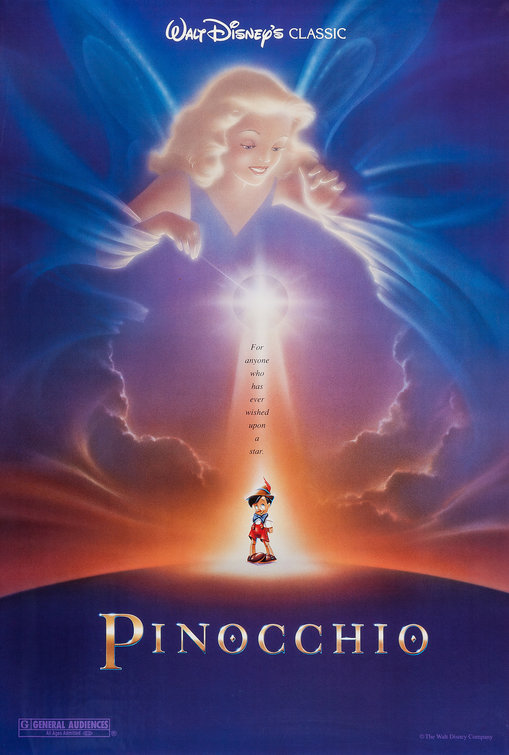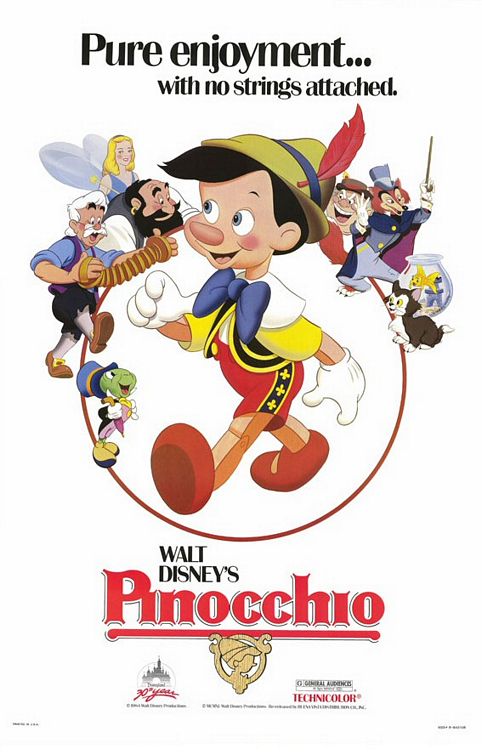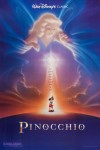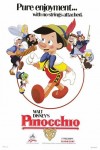Walt Disney’s Pinocchio is based on the Italian children’s novel The Adventures of Pinocchio by Carlo Collodi. It was the second animated feature film produced by Disney, made after the first animated success Snow White and the Seven Dwarfs (1937).
Pinocchio tells the story of an old wood-carver named Geppetto who carves a wooden puppet named Pinocchio. The puppet is brought to life by a blue fairy, who informs him that he can become a real boy if he proves himself to be “brave, truthful, and unselfish.” Pinocchio’s efforts to become a real boy involve encounters with a host of unsavory characters. Pinocchio was a groundbreaking achievement in the area of effects animation, giving realistic movement to vehicles, machinery and natural elements such as rain, lightning, smoke, shadows and water. The film was released to theaters by RKO Radio Pictures on February 7, 1940 (Walt Disney hadn’t launched Walt Disney Pictures yet).
Critical analysis of Pinocchio identifies it as a simple morality tale that teaches children of the benefits of hard work and conventional values. Although it became the first animated feature to win a competitive Academy Award – winning two for Best Music, Original Score and for Best Music, Original Song for “When You Wish Upon a Star” – it was initially a box office disaster, thanks to World War II. It eventually made a profit in its 1945 reissue, and is considered one of the greatest animated films ever made, with a 100% rating on the website Rotten Tomatoes. In 1994, Pinocchio was added to the United States National Film Registry for being deemed “culturally, historically, or aesthetically significant.” A live-action Pinocchio, from Oscar winning director Guillermo Del Toro, arrives in theaters in 2021.
Everything you need to know about Pinocchio.
At the very beginning of the movie, Jiminy Cricket explains that he is going to tell a story of a wish coming true. His story begins in the Italian workshop of a woodworker named Geppetto. Jiminy watches as Geppetto finishes work on a wooden marionette whom he names Pinocchio. Before falling asleep, Geppetto makes a wish on a star that Pinocchio will be a real boy. During the night, a Blue Fairy visits the workshop and brings Pinocchio to life, although he still remains a puppet. She informs him that if he proves himself brave, truthful, and selfless, he will become a real boy, and assigns Jiminy to be his conscience.
Geppetto discovers that his wish has come true, and is filled with joy. However, on his way to school, Pinocchio is led astray by Honest John the Fox and his companion, Gideon the Cat, who convinces him to join Stromboli’s puppet show, despite Jiminy’s objections. Pinocchio becomes Stromboli’s star attraction as a marionette who can sing and dance without strings. However, when Pinocchio wants to go home for the night, Stromboli locks him in a birdcage. Jiminy arrives to see Pinocchio and is unable to free him. The Blue Fairy appears and asks Pinocchio why he was not at school. Jiminy urges Pinocchio to tell the truth, but instead, he starts telling lies, which causes his nose to grow longer and longer. Pinocchio vows to be good from now on, and the Blue Fairy returns his nose to its original form and sets him free while warning him that this will be the last time she can help him.
Meanwhile, across town, Honest John and Gideon meet a coachman who promises to pay them money if they can find naughty little boys for him to take to Pleasure Island. Encountering Pinocchio on his way home, they convince him that he needs to take a vacation there. On the way to Pleasure Island, he befriends Lampwick, a delinquent boy. Without rules or authority to enforce their activity, Pinocchio and the other boys soon engage in smoking, gambling, vandalism, and getting drunk, much to Jiminy’s dismay. Later, while trying to get home, Jiminy discovers that the island hides a horrible curse: the boys brought to Pleasure Island transform into donkeys for their misbehavior and are sold into slave labor. Jiminy runs back to warn Pinocchio, only to discover that Lampwick has transformed into a donkey; Pinocchio manages to escape the island, only with donkey ears and a tail.
Upon returning home, Pinocchio and Jiminy find the workshop vacant. They soon get a letter from the blue fairy as a dove, stating that Geppetto had ventured out to sea to save Pinocchio from Pleasure Island, but was swallowed by a sperm whale named Monstro, and is now living in his belly. Determined to rescue his father, Pinocchio jumps into the sea accompanied by Jiminy. Pinocchio is soon swallowed by Monstro as well, where he is reunited with Geppetto. Pinocchio devises a scheme to make Monstro sneeze, giving them a chance to escape. The scheme works, but the enraged whale chases them and smashes their raft. Pinocchio pulls Geppetto to safety in a cave before Monstro crashes into it. Geppetto, Figaro, Cleo, and Jiminy are washed up safely on a beach, but Pinocchio is presumably killed.
Back home, Geppetto grieves over Pinocchio with Jiminy Cricket and the pets also mourn alongside. The Blue Fairy, however, decides that Pinocchio has proven himself brave, truthful, and selfless. To reward him, the Blue Fairy resurrects Pinocchio, reversing the Pleasure Island curse and turning him into a real boy. Pinocchio awakens and reveals that he is alive and a real human boy and everyone celebrates. Jiminy steps outside to thank the Fairy and is rewarded with a solid gold badge that certifies him as an official conscience.
The Cast:
Dickie Jones as Pinocchio, a wooden puppet carved by Geppetto, and turned into a living puppet by the Blue Fairy.
Cliff Edwards as Jiminy Cricket, a cheerful and wise cricket, who acts as Pinocchio’s “conscience”, and the partial narrator of the story.
Christian Rub as Mister Geppetto, a kind and elderly woodcarver, who creates Pinocchio, and wishes for him to become a real boy.
Figaro the cat and Cleo the goldfish are Geppetto’s pets. Figaro is a spoiled cat who is prone to jealousy. Cleo is a flirty little goldfish with a habit of being Figaro’s counselor.
Walter Catlett as “Honest” John Worthington Foulfellow, a sly anthropomorphic red fox who tricks Pinocchio twice in the film. Neither have speaking roles.
“Giddy” Gideon the Cat, Honest John’s mute, crafty, and anthropomorphic feline sidekick. He was originally intended to be voiced by Mel Blanc of Looney Tunes fame (in his second work for Disney until his final work in Who Framed Roger Rabbit), but the filmmakers removed his dialogue from the script in favor of a mute performance just like Dopey in Snow White and the Seven Dwarfs, the circus elephant title character Dumbo, and Tootles in Peter Pan. However, Gideon’s hiccups were provided by Blanc.
Charles Judels as Stromboli, a large, evil, bearded Italian puppet-maker, who forces Pinocchio to perform onstage in order to make money. He speaks with an Italian accent, and curses in Italian when he gets angry, though he is identified as a gypsy. He is the only character of the film to be part of the official Disney Villains line-up.
Judels also voiced the cruel and wicked Coachman, owner and operator of Pleasure Island, who enjoys turning unruly boys into donkeys and selling them off for labor.
Evelyn Venable as The Blue Fairy, who brings Pinocchio to life, and turns him into a real boy at the end of the film.
Frankie Darro as Lampwick, a naughty boy that Pinocchio befriends on his way to Pleasure Island. He is turned into a donkey on Pleasure Island.
Stuart Buchanan as the Carnival Barker, the announcer heard on Pleasure Island.





